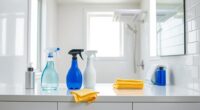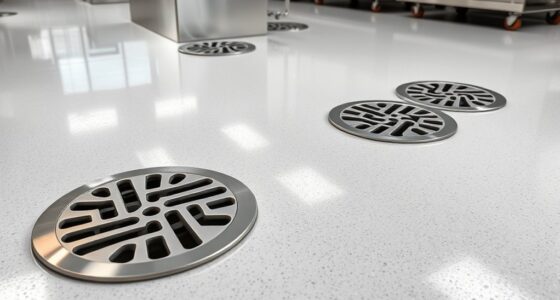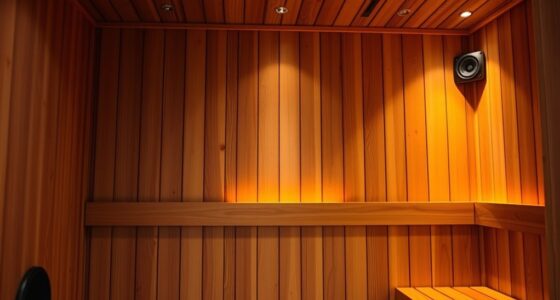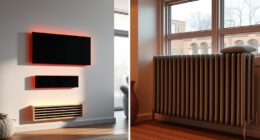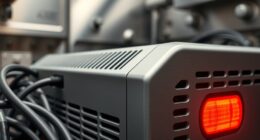Modern door systems use advanced hinges, sensors, and smart locks to make swinging doors safer and more convenient. Soft-close mechanisms prevent slamming, while sensors detect obstacles to avoid injuries. Electromagnetic locks and safety devices guarantee secure, quick access during emergencies. These innovations improve durability, reduce noise, and boost overall safety. If you want to understand how these features work together to protect and simplify your door experience, there’s more to explore ahead.
Key Takeaways
- Modern door swings rely on pivot hinges that allow smooth, controlled movement and prevent sagging or misalignment.
- Safety features like sensors and obstacle detection stop doors to prevent injuries or accidents.
- Electromagnetic locks provide quick, secure closure while maintaining high security standards.
- Soft-close mechanisms prevent slamming, reduce noise, and extend door lifespan.
- Automated sensors and safety response timings ensure doors operate smoothly and safely in various environments.
How Modern Door Hinges Work

Modern door hinges are designed to provide smooth, reliable movement while guaranteeing safety and durability. You’ll notice that door hinge mechanics rely heavily on the pivot point design, which acts as the central axis for opening and closing. This pivot point allows the door to swing freely while supporting its weight. High-quality hinges feature precise pin and knuckle construction, enabling consistent motion over time. When you operate a door, the hinge’s mechanics distribute the load evenly, reducing wear and tear. The pivot point design also helps prevent sagging and misalignment, maintaining proper door function. Overall, understanding how these components work together ensures you appreciate the craftsmanship behind modern hinges, which prioritize seamless operation and long-lasting performance. Additionally, the materials used in hinge construction influence their durability and performance, ensuring the hinges maintain their function over many years.
The Benefits of Soft-Close Door Mechanisms
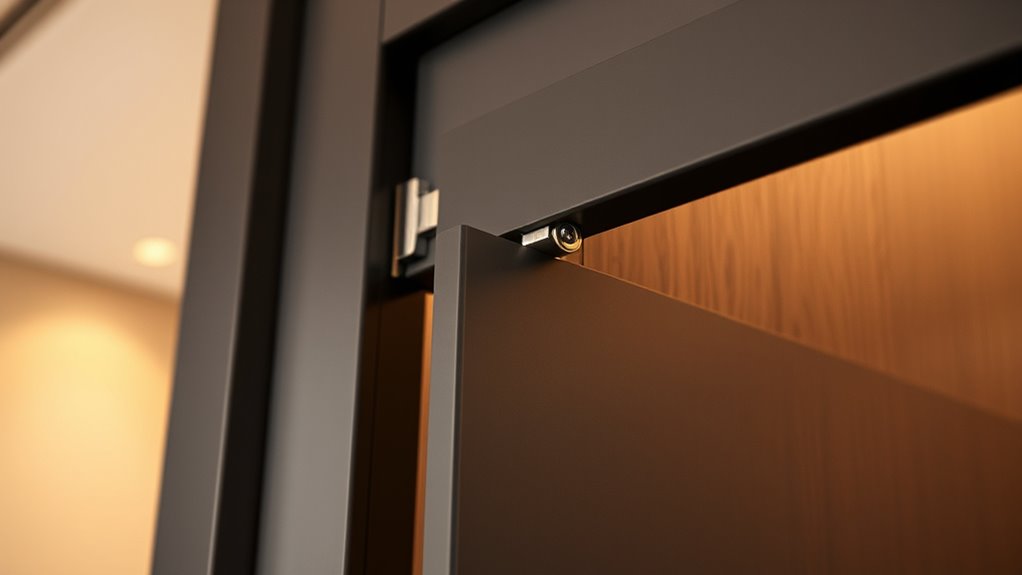
Soft-close door mechanisms help prevent slamming accidents, keeping you and others safe. They also reduce noise, making your space more peaceful. Plus, they extend the door’s lifespan by minimizing wear and tear. Incorporating wall organization systems can further enhance safety and organization in your home.
Prevents Slamming Accidents
Slamming doors can cause injuries, damage property, and create noise disturbances, making safety a top priority. Soft-close door mechanisms prevent these accidents by controlling the door’s movement, ensuring it closes gently. This feature not only enhances safety but also preserves door aesthetics, maintaining a clean, seamless look. Installing soft-close systems might present some installation challenges, but the benefits outweigh the effort. Additionally, incorporating advanced projector technology can improve the overall ambiance and safety of your space by reducing harsh lighting and providing clearer visuals.
Consider these points:
- Reduces risk of pinched fingers and impact injuries
- Protects delicate finishes from sudden force
- Maintains a calm, quiet environment
- Extends door lifespan by minimizing wear and tear
- Enhances overall safety and convenience
Soft-close mechanisms are a smart upgrade, making your space safer without compromising style or functionality.
Reduces Noise Levels
By controlling the speed and force of a door’s closing motion, soft-close mechanisms considerably reduce noise levels in your space. This noise reduction makes daily activities more peaceful and minimizes disruptions. Soft-close technology dampens the impact when doors shut, preventing loud slamming sounds. It also enhances soundproofing techniques by lowering the transfer of noise between rooms. If you value tranquility, these mechanisms help create a quieter environment, whether at home or in the office. Not only do they cut down on noise pollution, but they also contribute to a calmer atmosphere. With soft-close systems, you’ll notice a significant difference in noise levels, making your space more comfortable and less disruptive for everyone inside.
Extends Door Lifespan
When doors close abruptly or forcefully, they endure unnecessary wear and tear that shortens their lifespan. Soft-close door mechanisms help prevent this by allowing smooth, controlled closures. This reduces stress on the door hinge lubrication and minimizes damage to weatherproof door frames. As a result, your door stays in better shape longer, saving you money on repairs and replacements. Properly maintained hinges and sturdy frames work together to support longevity. Additionally, soft-close systems reduce impact damage, lessen vibrations, and prevent misalignment. They also lower the risk of hinges loosening or breaking over time. By choosing these mechanisms, you guarantee your door remains functional and reliable for years to come, making maintenance less frequent and preserving its overall durability. Incorporating best products can further enhance the effectiveness of your soft-close system and ensure optimal performance.
Automatic Door Sensors and Motion Activation
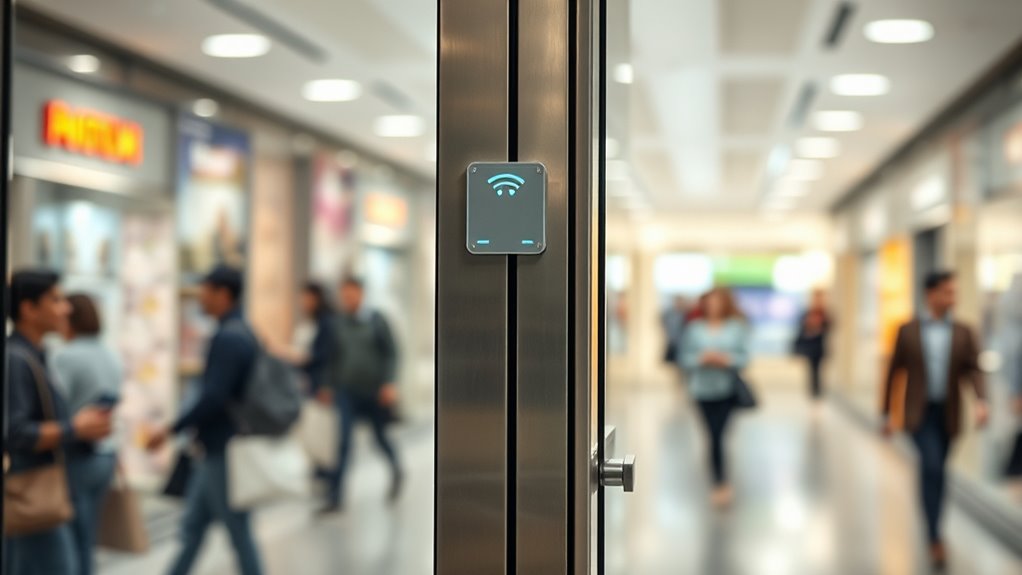
Automatic door sensors detect motion within specific zones, ensuring the door opens only when needed. You should be aware of how sensor activation zones are set to prevent accidental openings or failures. Additionally, safety response timings are vital for smooth operation and avoiding injuries, so understanding how quickly the system reacts is key. Incorporating AI-driven safety features can further enhance the reliability and responsiveness of automatic door systems.
Sensor Activation Zones
Sensor activation zones are carefully designed areas where automatic door sensors detect movement or presence to trigger door operation. Proper calibration guarantees sensors respond accurately, avoiding false openings or failures. Zone overlap is critical; it prevents gaps where sensors might miss motion, ensuring seamless door activation. When sensors are well-calibrated, activation zones are optimized for efficiency and safety. If zones are improperly set, it can cause delays or accidental door closures, risking injury or inconvenience. Understanding zone design helps you recognize how sensors work together to monitor entry points effectively. Key considerations include:
- Accurate sensor calibration for responsiveness
- Preventing zone overlap to avoid false triggers
- Ensuring complete coverage of the doorway
- Adjusting zones for different traffic flows
- Maintaining sensor alignment for safety
- Proper zone design enhances overall security zone effectiveness and reduces the risk of malfunctions.
Safety Response Timings
Proper calibration of activation zones ensures sensors respond quickly and accurately to movement, but timing also plays a vital role in overall safety. When sensors activate, the door latch mechanisms must engage promptly to prevent accidents. If response times are delayed, it increases the risk of someone being caught or injured. Adjusting hinge tension helps control how fast the door opens and closes, ensuring smooth operation without sudden movements. Regularly checking and fine-tuning hinge tension adjustments can optimize safety response timings. This guarantees that the door reacts swiftly when someone approaches, reducing the chance of injury. Precise timing between sensor activation, latch engagement, and door movement is essential for a safe and efficient automatic door system. Proper maintenance keeps everything working harmoniously, safeguarding everyone around the door. Additionally, understanding the lifestyle factors that influence work environments can help in designing safer, more ergonomic spaces around automatic doors.
Safety Features in Automated Doors
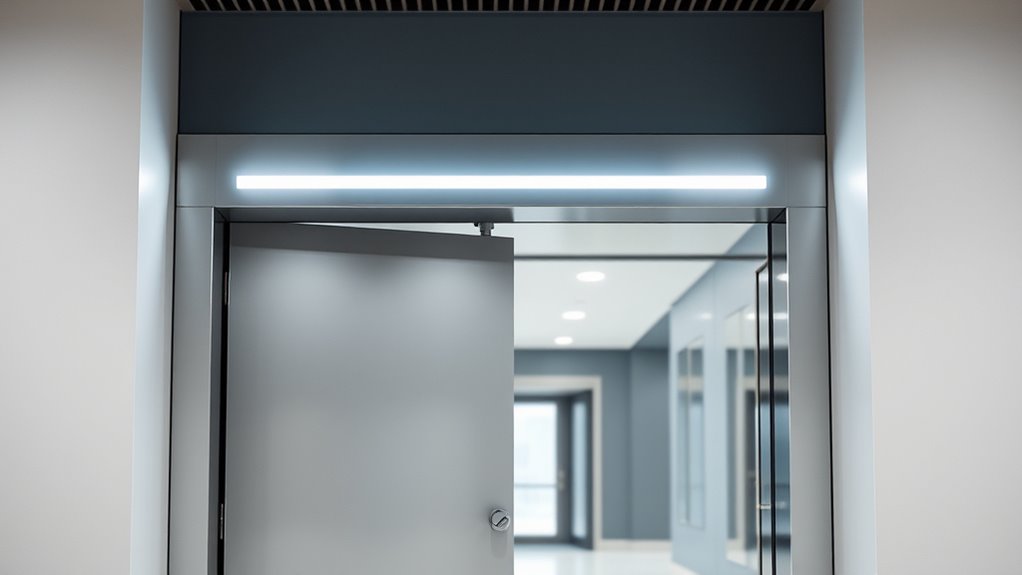
To guarantee safety, automated doors are equipped with a variety of features designed to prevent accidents and injuries. These include sensors that detect obstacles, emergency stop buttons, and safety edges that trigger door closure if something is in the way. Door hinge mechanisms are carefully designed to allow smooth, controlled movement, reducing pinching risks. The soft close advantages ensure the door closes gradually, preventing slamming and reducing injury risk. Additional safety features include flashing lights to signal movement and anti-fallback systems that prevent sudden drops. These measures work together to create a safer environment, giving you peace of mind. Understanding these safety features helps you appreciate the advanced technology working silently to protect users and maintain smooth operation. Regular maintenance of automatic door components is essential to ensure all safety features function correctly and reliably.
Understanding Electromagnetic Locking Systems

Electromagnetic locking systems play a crucial role in securing automated doors by using powerful magnets to hold the door in place when locked. These electromagnetic locks, or maglocks, rely on magnetic security to provide a strong, reliable hold without mechanical parts. When the lock is activated, an electric current energizes the magnet, creating a magnetic field that secures the door firmly. This system allows for quick release when power is cut or a release signal is given, ensuring safety and convenience. Electromagnetic locks are popular in high-security environments because they are difficult to tamper with and require minimal maintenance. Their simplicity and effectiveness make them a key component in advanced door security, providing peace of mind while maintaining smooth operation. Additionally, understanding the safety standards for such systems ensures that they are installed and maintained correctly for maximum security and reliability.
The Role of Sensors in Preventing Door Injuries

Sensors play a vital role in keeping doorways safe by detecting obstacles and preventing injuries. Different types, like infrared and pressure sensors, serve specific functions to guarantee accuracy. Understanding how these sensors work helps you appreciate their impact on overall door safety. For example, pressure sensors can detect objects or individuals in the path of a door, triggering an automatic stop to prevent accidents.
Sensor Types and Functions
When it comes to preventing door injuries, the various types of sensors play a crucial role in detecting obstructions and ensuring safe operation. Different sensors, like infrared, ultrasonic, and pressure sensors, serve unique functions in safety systems. Proper sensor calibration is essential to ensure accurate detection, while correct sensor placement maximizes effectiveness. Selecting the right sensor type depends on your door’s environment and usage. Keep in mind:
- Calibration adjusts sensitivity for precise obstacle detection
- Placement ensures sensors cover all potential obstruction zones
- Infrared sensors detect movement through light beams
- Ultrasonic sensors measure distance with sound waves
- Pressure sensors sense physical contact or pressure changes
How Sensors Detect Obstacles
Obstacles in the path of a door can pose serious safety risks, but effective detection methods help prevent injuries. Sensors play a vital role in obstacle detection by constantly monitoring the area around the door. Proper sensor calibration ensures these devices accurately identify objects, avoiding false alarms or missed detections. When an obstacle is detected, the sensor sends a signal to stop or reverse the door’s movement, preventing injuries. Different sensors, like infrared or ultrasonic, use specific technologies to detect presence or motion. Regular calibration is essential to maintain reliability, especially in changing environments. This precise obstacle detection system allows your door to respond swiftly, keeping people safe and reducing the risk of accidents.
Impact on Door Safety
By actively monitoring the area around a door, sensors substantially reduce the risk of injuries caused by accidental contact or entrapment. They improve door safety by quickly detecting obstacles or human presence, preventing unexpected closures. This technology complements door hinge mechanisms, ensuring smoother operation while minimizing injury risks. Sensors can also adapt to different door materials, enhancing safety regardless of whether the door is glass, metal, or wood.
- Reduce pinching or crushing injuries
- Prevent door closures on children or pets
- Enhance safety in high-traffic areas
- Minimize damage to door material
- Improve overall safety standards and compliance
Innovations in Emergency Door Safety Devices
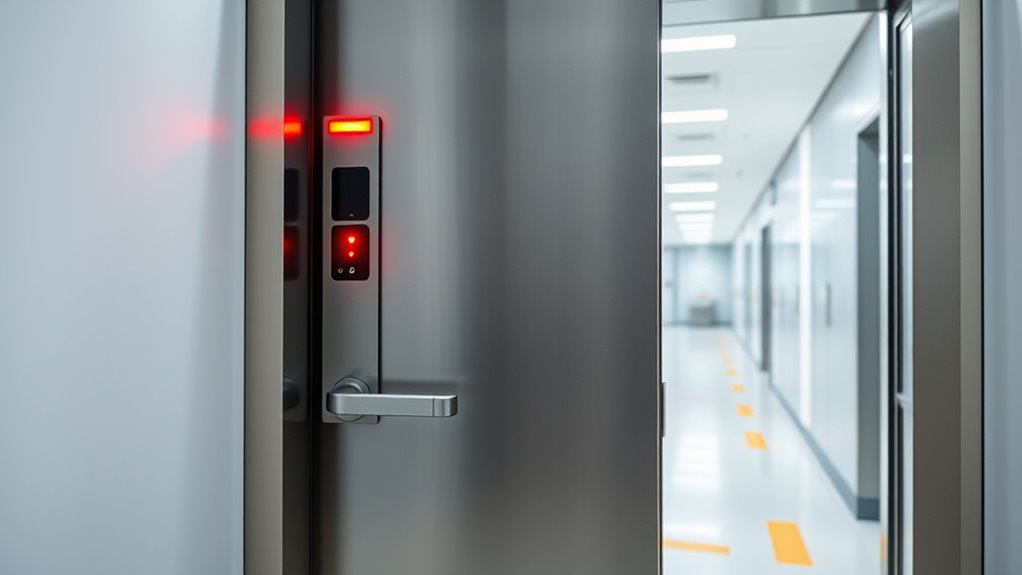
Innovations in emergency door safety devices are transforming how buildings guarantee quick and reliable evacuation during crises. New systems like automatic door openers and crash-resistant hardware ensure doors respond instantly. These advancements make it easier for everyone to exit safely without delays. Imagine a door that senses an emergency and swings open smoothly, thanks to improved door hinge lubrication and durable, aesthetic door handles designed for easy grip and quick access. Here’s a visual:
| Emergency Device | Features |
|---|---|
| Crash-resistant hardware | Withstands impact and prevents jamming |
| Automatic openers | Activate upon emergency signals |
| Enhanced handles | Ergonomic, easy to operate under stress |
These innovations create safer environments, combining functionality with sleek design and reliable performance.
How Smart Doors Communicate and Respond

Smart doors are equipped with advanced communication systems that enable instant response to emergency signals and environmental changes. When sensors detect motion, temperature shifts, or security breaches, the door reacts swiftly, ensuring safety and efficiency. This responsiveness minimizes the need for frequent door maintenance by preventing wear caused by manual operation. It also enhances aesthetic design, as seamless integration of sensors and controls keeps the appearance sleek and unobtrusive.
- Immediate alerts notify you of issues or security breaches
- Adaptive responses improve safety during emergencies
- Integration with building systems streamlines door management
- Customizable settings maintain aesthetic appeal
- Reduced manual intervention lowers maintenance costs
Materials and Design for Enhanced Durability and Safety

Selecting the right materials and design features is essential for guaranteeing your door can withstand daily use and environmental stresses. Durable materials like steel, hardwood, or reinforced composites increase longevity and safety. Proper hinge installation ensures smooth operation and prevents accidents, especially with heavy or frequently used doors. When choosing a door handle, opt for sturdy, tamper-resistant options to enhance security. The following table highlights key materials and their advantages:
| Material | Durability | Safety Feature |
|---|---|---|
| Steel | High resistance | Strong hinge points, secure handle design |
| Hardwood | Long-lasting | Reliable hinges, solid grip |
| Reinforced Composite | Weather-resistant | Enhanced safety, minimal maintenance |
Prioritize these elements for a safer, more durable door.
Future Trends in Door Technology
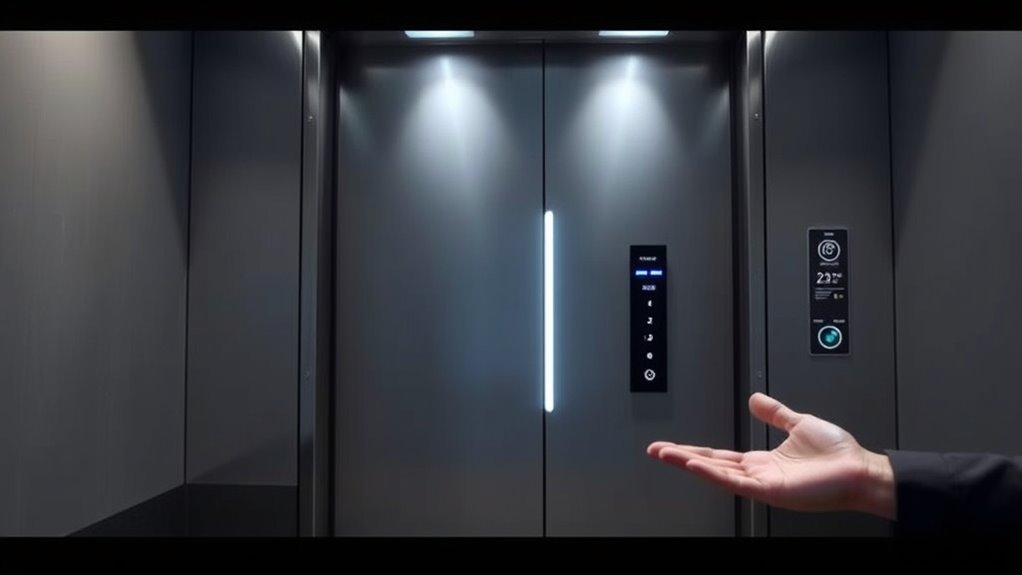
Advancements in materials and design have paved the way for smarter, more efficient door technologies. Future trends focus on enhancing door security while maintaining aesthetic innovations. Expect smart locks with biometric access, making unauthorized entry nearly impossible. Integrated sensors will improve safety by automatically detecting obstacles and adjusting swing paths. Lightweight, durable materials will enable sleek designs without sacrificing strength. Additionally, aesthetic innovations will blend doors seamlessly into modern architecture, offering customizable finishes and minimalistic styles. These developments aim to provide you with more secure, visually appealing options that adapt to your needs. As technology evolves, doors will become smarter, safer, and more stylish—delivering peace of mind and elegance in equal measure.
Frequently Asked Questions
How Do I Troubleshoot Door Sensor Malfunctions Effectively?
To troubleshoot door sensor malfunctions, start by checking the wiring issues—ensure all connections are secure and undamaged. Next, perform sensor calibration by adjusting the sensor’s position and sensitivity settings. If the problem persists, test the sensor with a multimeter to verify it’s functioning correctly. Regularly clean the sensor lens and look for any obstructions that may interfere with its operation. This approach helps identify and resolve common issues effectively.
Are There Regulations Governing Automatic Door Safety Standards?
Yes, there are strict regulations governing automatic door safety standards, and ignoring them is like playing with fire. You must guarantee compliance with local, national, and international regulations to keep everyone safe. These rules cover sensor placement, emergency stop functions, and safety edges. By adhering to regulatory compliance, you minimize risks and guarantee your doors meet safety standards, protecting both people and your business from costly accidents and legal issues.
Can Advanced Door Systems Be Integrated With Existing Security Setups?
Yes, you can integrate advanced door systems with your existing security setups. Focus on smart integration and system compatibility to guarantee seamless operation. Check if the new system supports your current access control, alarm, and surveillance devices. Often, compatibility depends on open protocols or adaptable interfaces. You might need a professional to configure the integration properly, ensuring your security remains robust while benefiting from the advanced door features.
What Maintenance Is Required for Electromagnetic Locking Systems?
You might worry maintenance is complicated, but electromagnetic locking systems are straightforward. You should follow a regular maintenance schedule that includes component inspection, ensuring power supplies and wiring remain secure and functional. Check for signs of wear or damage, clean contacts, and test the lock’s operation periodically. Proper upkeep prevents malfunctions, enhances security, and extends the system’s lifespan, making your safety measures reliable and hassle-free.
How Do Environmental Factors Affect Door Sensor Performance?
Environmental factors can substantially impact your door sensor’s performance. You need to regularly check sensor calibration to ensure accuracy, especially if conditions change. Environmental interference from dust, dirt, moisture, or extreme temperatures can disrupt sensor signals, causing false alarms or malfunctions. Keep sensors clean, protect them from harsh elements, and monitor their performance to maintain reliable operation. Addressing these factors helps prevent false triggers and ensures safety and security.
Conclusion
As you step through a door that glides smoothly, powered by smart sensors and reinforced by durable materials, you’re experiencing the future of safety and convenience. These innovations create a seamless progression between spaces, like a gentle handshake rather than a sudden barrier. With every hinge and sensor working in harmony, you can move confidently, knowing that safety is built into every detail. Embrace these advancements and walk into tomorrow’s doors today.

